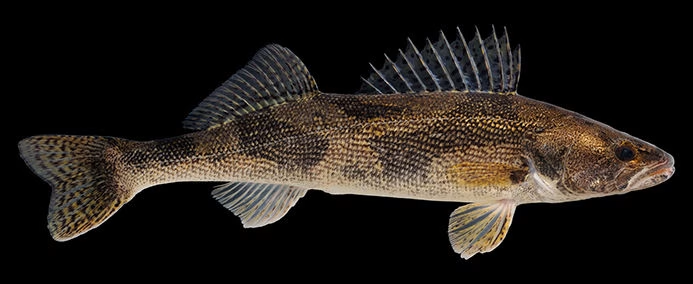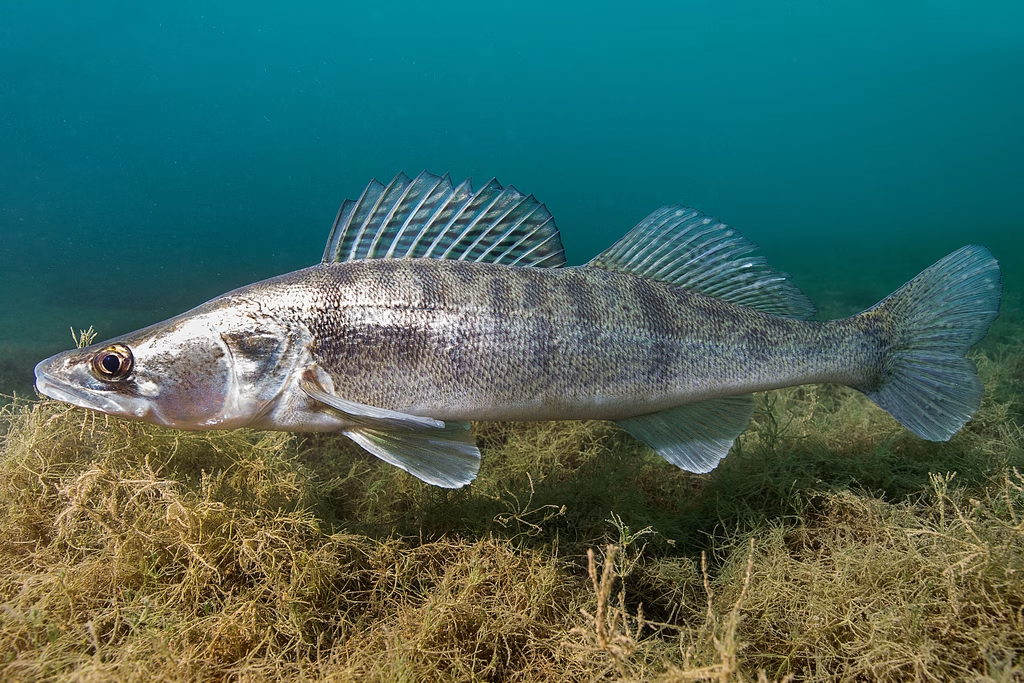Zander (Sander lucioperca)is a well-known fish species in European lakes and rivers. But what about its cousin, Sauger (Sander canadensis)? A common fish species in North America. They both come from the Sander genus and they can look pretty similar to untrained eyes. Join me as we compare these two popular game fishes. Let’s see what are the biggest differences in the Zander vs Sauger comparison.
Zander vs Sauger – Differences
Body Shape and Size
The Zander has an elongated and streamlined body shape, typically growing larger than the sauger. Zander can reach lengths of up to 100 cm (3.3 ft), while sauger generally max out around 50-70 cm (1.6-2.3 ft).
Additionally, Zander has a more slender build compared to the stockier sauger. Zander’s body is also characterized by a more pronounced lateral line, which contributes to its sleek appearance, whereas the sauger’s body features a fuller, bulkier profile. These differences in size and shape make them distinct when viewed side by side.


Native Range and Habitat
The zander is native to freshwater and brackish environments across continental Europe to western Siberia. It thrives in eutrophic lakes, brackish coastal lakes, and large turbid rivers, where it prefers areas with ample cover and structure. Anglers recognize zander for their migratory behavior, as they often travel up to 250 kilometers to reach spawning grounds.
In contrast, the sauger is primarily found in the northern United States and Canada, inhabiting rivers, lakes, and reservoirs, favoring sandy or rocky substrates with moderate currents. Both species demonstrate a preference for habitats that support abundant prey availability.
Feeding Behavior
Zander vs. Sauger: These fish exhibit distinct feeding behaviors shaped by their environments and prey preferences. Zander are aggressive predators that chase small fish such as smelt and European perch in zigzag patterns, primarily during dusk and dawn. Their hunting strategy relies on quick, dynamic movements.
On the other hand, saugers tend to be opportunistic feeders, often lurking in murky water and using their heightened sensitivity to low-light conditions. They primarily target perch and freshwater drums, employing a more stealthy approach than zander, allowing them to capitalize on their surroundings and ambush unsuspecting prey.
Reproduction and Spawning Habits
Zander vs. Sauger: These fish exhibit distinct reproductive behaviors. Zander spawns in flowing bodies of water, with males establishing and defending territories by creating shallow depressions in gravel. They spawn in spring, often in pairs, and lay eggs in nests.
Saugers typically spawn in slower-moving, calm waters, preferring sandy or rocky substrates, and often aggregate in larger groups during this period. While both species lay adhesive eggs that hatch within a few days, zander’s preference for flowing environments contrasts with sauger’s affinity for more stable, low-velocity habitats.
Zander vs Sauger – Similarities
Family and Taxonomy
Both species share a similar taxonomic classification and exhibit features typical of the Percidaes (perch family).
In terms of body morphology, zander and sauger can appear quite alike, leading to potential confusion between the two species. Both have elongated bodies, streamlined for efficient swimming. However, notable differences exist in their coloration and markings. Zander typically exhibits a green to blue-grey coloration on its sides, with a contrasting white belly, while the sauger boasts a darker hue characterized by large, dark saddle-like patches.
Another prominent distinguishing feature is the presence of blotchy, black spots on the sides of the zander, which are less pronounced in sauger. This spotting is a key identifier, as sauger generally displays a more uniform color without such distinct markings.
Fins also provide vital clues for identification. Zander possesses two dorsal fins, with the first one characterized by spines and the second by soft rays. This configuration is similar in sauger, yet the latter’s dorsal fin may present subtle differences in shape and size. Additionally, both species have an anal fin comprising 2 to 3 spines paired with multiple soft rays, a common trait within the family.
A critical taxonomic difference arises with the gill cover. Zander’s gill cover does not feature a spine, which distinguishes it from the sauger, whose gill cover includes a prominent short, sharp spine. This absence of a spine on the zander can serve as an effective diagnostic trait for anglers and ichthyologists alike.
Ecosystem Roles
Zander vs. Sauger: Though they hail from different continents, both share important similarities in their roles within their respective ecosystems.
Zander, a European fish often found in deeper, oxygen-rich freshwater lakes and rivers, while the Sauger, an American fish, thrives in the murky waters of the northern United States and Canada. Despite their geographical differences, the two species exhibit comparable predatory behaviors that allow them to function as significant contributors to their aquatic environments.
Both Zander and Sauger (only northern pikes and muskies can compare) are apex predators within their ecosystems, exerting considerable influence on the populations of smaller fish species. Their primary diets consist of smaller fish, which they hunt using similar strategies. Zander are known for their agile hunting style, taking advantage of their keen eyesight in low-light conditions. In contrast, Sauger employs their excellent night vision and reflective eyes to locate prey during dusk and dawn, times when their activity peaks. This nocturnal hunting behavior allows both species to effectively manage the populations of their prey, thereby maintaining a balance within the aquatic food web.
In addition to their direct predatory roles, Zander and Sauger also compete for similar resources within their environments. Both species require adequate shelter and foraging areas, often seeking out structures like submerged logs or rocks in rivers and lakes. This competition can influence the dynamics of the ecosystems they inhabit, affecting not only the populations of prey fish but also other predator and competitor species.
Ultimately, the similarities in the roles played by Zander and Sauger highlight their importance in regulating fish populations and maintaining ecological balance. Both species exemplify the intricate interdependencies present within aquatic ecosystems, underscoring the need for careful management of their populations and habitats to ensure ecological health and sustainability.
What’s More Popular as a Game Fish?
When it comes to the world of sport fishing, both zander and sauger have carved out their own niches, attracting anglers with their unique characteristics and the thrilling challenges they present. However, popularity can vary significantly based on geography, fishing culture, and the ecosystems in which these fish thrive.
Zander: The European Favorite
Anglers highly seek Zander, often referred to as Pike-Perch, across various lakes and rivers in Europe. Notably, they flock to the vast waterways of Germany, France, and Hungary where zander can reach impressive sizes, often weighing between 10 to 20 pounds, with some individuals even going into the 30-40 pound range. Anglers know these fish for their fierce fighting abilities, making them an exhilarating catch.
Fishing licenses are a crucial part of the angling experience in Europe. Regulations vary by country, but obtaining a fishing license is generally required to fish in public waters. In countries like Germany, anglers must adhere to specific seasons and quotas to ensure sustainable fishing practices, particularly for species like zander that are prized for their culinary qualities and sportfishing appeal.
The thrill of catching a monster fish is not just about the size; it’s also about the fight. Zander are known for their aggressive nature, especially when hooked, and can make spirited runs that challenge even the most seasoned anglers. Stories abound of anglers battling these beasts for what seems like ages, only to finally reel in a trophy that becomes the centerpiece of their fishing tale.
Sauger: The North American Contender
On the other side of the Atlantic, the sauger reigns as a favored game fish in North America. Found mainly in the fresh water of the Mississippi River and its tributaries, as well as in various lakes across the Midwest and Northern states, saugers are similar to their relatives, the walleye, but offer a distinct fishing experience. While saugers tend to be smaller than zander, averaging around 2 to 5 pounds, they can still put up a fight that is both challenging and rewarding.
Fishing licenses are equally essential for sauger anglers in the U.S. Each state has its regulations, with specific licensing requirements and catch limits. Anglers in states like Minnesota and Wisconsin often share stories of successful trips to the Mississippi River, where the thrill of catching a sauger is heightened by the fish’s cunning behavior and the scenic beauty of the river itself. Now that I am mentioning licenses and regulations. Read about the Oregon barbless hook law and inform yourself in case you plan to fish there.
Monster sauger stories are less common than those about zander, but that does not diminish their allure. Many anglers recount the excitement of hooking into a hefty sauger, feeling the powerful head shakes and determined runs as the fish attempts to escape. The experience of reeling in a sauger that challenges their skill and tackle is a point of pride for many North American anglers.
